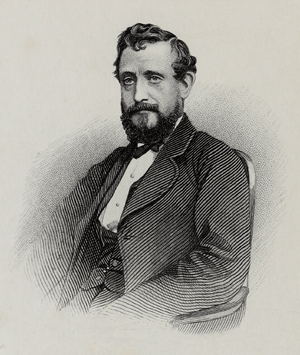James Thomson (poet, born 1834) facts for kids
Quick facts for kids
|
|
|---|---|
 |
|
| Born | 23 November 1834 Port Glasgow, Scotland |
| Died | 3 June 1882 (aged 47) London, England |
| Pen name | Bysshe Vanolis |
| Education | Royal Military Academy |
| Period | 1863–1882 |
| Notable works | The City of Dreadful Night |
| Signature | |
James Thomson (born November 23, 1834 – died June 3, 1882) was a Scottish poet from the Victorian era. He is best known for his long poem The City of Dreadful Night. This poem shares a very sad and gloomy view of life in a big city.
Thomson used a special pen name, or pseudonym, which was Bysshe Vanolis. He created this name by combining parts of the names of two other poets: Percy Bysshe Shelley and Novalis. To tell him apart from an older Scottish poet also named James Thomson, people often add "B.V." after his name.
Even though his poems are not often found in modern collections, some of his works, like "Insomnia" and "Mater Tenebrarum," are still highly thought of. Thomson admired and translated the works of an Italian poet named Giacomo Leopardi, who also wrote about sad topics. Thomson's own poems were considered even more gloomy. He was known as "The Laureate of Pessimism" (meaning the poet of sadness) after he passed away in 1882.
His Life Story
James Thomson was born in Port Glasgow, Scotland. When he was eight years old, his sister died and his father became very ill. Because of this, James was sent to an orphanage in London called the Royal Caledonian Asylum. Soon after, his mother also passed away. He grew up speaking with a London accent.
He trained to be an army schoolmaster at the Royal Military Asylum in Chelsea. In 1851, when he was 17, he served in Ireland. There, he met 18-year-old Charles Bradlaugh. Bradlaugh was known for being a freethinker, meaning he formed his own ideas based on logic, not just what was traditionally believed. He had already written about not believing in God a year earlier.
More than ten years later, Thomson left the army and moved back to London. He worked as a clerk, which is someone who handles office tasks. He stayed in touch with Bradlaugh, who had started his own weekly newspaper called National Reformer. This paper was for working people.
From 1863 until he died, Thomson wrote stories, essays, and poems for different newspapers and magazines. Many of his works, including his most famous poem, The City of Dreadful Night, were published in the National Reformer.
The City of Dreadful Night was written during a time when Thomson struggled with not being able to sleep and feeling very sad and down. He started to spend more time alone and sometimes argued with his friend Bradlaugh. In 1880, about a year and a half before he died, his book of poems, The City of Dreadful Night and Other Poems, received good reviews from critics. However, this positive attention came too late to help Thomson, as his health and mood continued to get worse.
He passed away in London at the age of 47 due to a serious health issue.
His Lasting Impact
Seven years after James Thomson's death, in 1889, a writer named Henry Stephens Salt published a book about Thomson's life. It was called The Life of James Thomson ("B.V.") and included some of his writings. Later, in 1910, another biography was written by Bertram Dobell. These books helped keep Thomson's memory and works alive.
Selected Publications
- The Captive Chief: A Tale of Flodden Field and Other Poems (1871)
- The City of Dreadful Night (1874)
- The City of Dreadful Night and Other Poems (1880)
- Vane's Story, Weddah and Om-el-Bonain, and Other Poems (1881)
- Essays and Phantasies (1881)
- Satires and Profanities (1884; with preface by George William Foote)
- A Voice from the Nile, and Other Poems (1884; with memoir by Bertram Dobell)
- Shelley, a Poem: With Other Writings Relating to Shelley, to Which Is Added An Essay on the Poems of William Blake (1884; with preface by Bertram Dobell)
- Selections from Original Contributions by James Thomson to "Cope's Tobacco Plant." (1889; with preface by Walter Lewin)
- Poems, Essays and Fragments (1892; edited, with preface, by J. M. Robertson)
- The Poetical Works of James Thomson: The City of Dreadful Night, Vane's story, Weddah & Om-el-Bonain, Voice from the Nile & Poetical Remains, Vol. I / Vol. II (1895; edited, with memoir, by Bertram Dobell)
- Biographical and Critical Studies (1896; with preface by Bertram Dobell)
- Walt Whitman: The Man and the Poet (1910; with introduction by Bertram Dobell)
Images for kids
See also
 In Spanish: James Thomson (B.V.) para niños
In Spanish: James Thomson (B.V.) para niños





